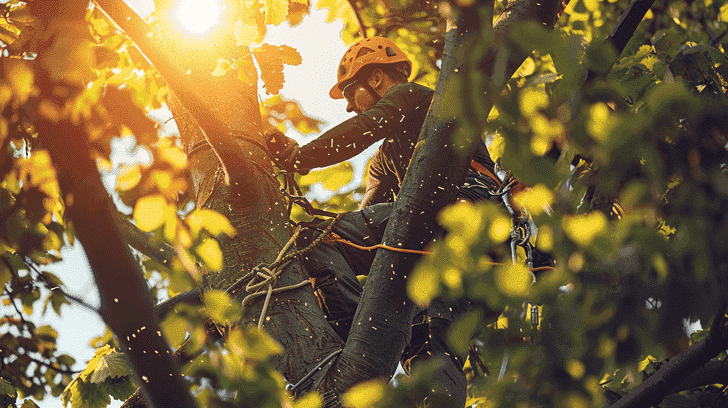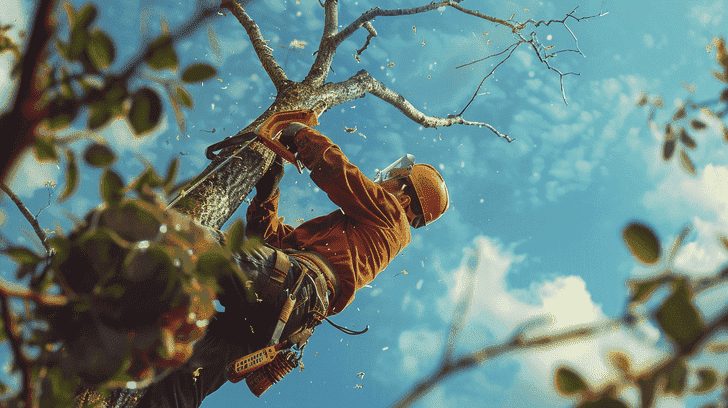How Long Does Tree Trimming Take? Factors and Timeframes
When you consider the duration of tree trimming, factors like tree size, type, branch complexity, and health can greatly impact the timeframes involved in this important task.
Small trees, under 30 feet, generally take 1 to 2 hours, while medium trees, ranging from 30 to 60 feet, may require 2 to 4 hours. Larger trees exceeding 60 feet can take approximately 4 to 8 hours to trim properly.
Understanding these timeframes is essential for effective planning and ensuring the best care of your trees. Various factors can influence the duration, so precise knowledge is key to successful tree maintenance.
Factors Affecting Tree Trimming Duration
When determining the duration of tree trimming, factors such as tree size and type play important roles.
The health and condition of the tree also greatly impact how long the trimming process will take.
Understanding these key points will help you estimate the time needed for effective tree trimming.
Tree Size and Type
Determining the appropriate tree size and type is essential in accurately estimating tree trimming duration.
Tree size plays a significant role in the time needed for trimming, with larger trees requiring more work than smaller ones.
The type of tree also influences the duration; for instance, deciduous trees might need different pruning techniques compared to evergreens.
Branch structure is another factor to take into account, as trees with complex branching patterns can be more time-consuming to trim.
Additionally, obstacles around the tree, such as power lines or buildings, can affect the trimming process.
By evaluating these aspects thoughtfully, you can better gauge the time required for tree trimming, ensuring a more efficient and effective maintenance process.
Tree Health and Condition
To accurately estimate the duration needed for tree trimming, it’s imperative to assess the health and condition of the tree, as these factors greatly impact the trimming process.
Before initiating any trimming, a thorough assessment of the tree’s health is essential. Factors such as the presence of diseases, pests, deadwood, or decay can greatly influence the duration required for trimming.
Planning the trimming process based on the tree’s health status is vital to make sure the job is completed efficiently and effectively.
Healthy trees may require less time for trimming compared to trees with underlying health issues.
By considering tree health as a primary factor in the duration of tree trimming, you can strategize and execute the trimming process more effectively.
Tools and Equipment Utilized in Tree Trimming
When it comes to tree trimming, the tools and equipment used are vital for efficiency and safety.
Pruning tools like pruning shears and loppers are essential for precise cuts and shaping.
Climbing gear such as harnesses and ropes enable arborists to access tall branches safely, while safety equipment like helmets and gloves protect against potential hazards.
Pruning Tools
Selecting the right pruning tools is essential for efficient and effective tree trimming. To guarantee a successful pruning process, consider the following:
- Hand Pruners: Ideal for small branches and precise cuts, hand pruners offer precision and control. Make sure they’re sharp for clean cuts that promote tree health.
- Loppers: Best suited for branches with a diameter of up to 2 inches, loppers provide extra reach and cutting power. Regular maintenance is vital to keep them in top condition.
- Pruning Saw: When dealing with larger branches, a pruning saw is indispensable. Its sharpness and cutting efficiency are paramount for clean and proper cuts, reducing the risk of tree damage.
Climbing Gear
For maximum safety and efficiency during tree trimming tasks, employing the right climbing gear is essential in ensuring successful completion of the job. Climbing gear is an indispensable component in the arsenal of tree-trimming professionals.
Harnesses, climbing ropes, ascenders, and carabiners are indispensable tools that provide access to the tree canopy.
The harness secures you to the tree, while climbing ropes and ascenders help you ascend with ease and precision.
Carabiners are used to attach various tools for easy access while working aloft.
Professionals rely on this specialized equipment to navigate the tree canopy safely and efficiently.
Investing in quality climbing gear is crucial for anyone looking to undertake tree trimming tasks effectively.
Safety Equipment
For best safety and efficiency during tree trimming tasks, using the appropriate safety equipment is essential for successful completion of the job.
When participating in DIY tree trimming activities, make sure you have the following safety gear:
- Hard Hat: Protect your head from falling branches or debris.
- Safety Harness: Secure yourself to the tree when climbing to prevent falls.
- Safety Glasses: Shield your eyes from wood chips, dust, and debris during cutting.
These tools not only guarantee your safety but also contribute to a more streamlined tree trimming process.
Remember, safety should always be the top priority when undertaking tree trimming tasks to avoid injuries and potential accidents.
Steps Involved in the Tree Trimming Process
To begin the tree trimming process, you must first conduct a thorough assessment and plan the necessary steps.
Once the area is cleared and safe, proceed with trimming the tree according to your plan.
After the trimming is complete, focus on cleaning up the debris and properly disposing of it to finish the process efficiently.
Assessment and Planning
Evaluating and strategizing are critical initial steps in the tree trimming process to guarantee the best health and aesthetics of the trees on your property. To secure a successful tree trimming operation, follow these key steps:
- Tree Inspection: Thoroughly examine each tree to identify weak or diseased branches that need to be pruned.
- Goal Setting: Define the specific objectives of the trimming, whether it be improving tree structure, enhancing sunlight penetration, or maintaining a certain height.
- Resource Planning: Determine the tools, equipment, and manpower required for the job to streamline the process and maximize efficiency.
Clearing the Area
When preparing to clear the area for tree trimming, conduct a thorough assessment of the surroundings to guarantee safety and efficiency. Look for obstacles like power lines, nearby structures, or other trees that could impede the trimming process.
Clear out any debris, such as fallen branches or rocks, that might hinder movement or pose a safety risk. Make sure there’s enough space for the tree trimmers to work comfortably and safely.
Additionally, check for any environmental factors like the presence of wildlife or fragile vegetation that may need protection during the trimming process. By meticulously clearing the area before starting the tree trimming, you set the stage for a smooth and successful operation.
Trimming the Tree
When trimming a tree, you’ll start by removing dead or diseased branches to promote healthy growth.
Next, shaping the tree for aesthetic purposes will enhance its overall appearance and structure.
Removing Dead or Diseased Branches
To effectively trim a tree by removing dead or diseased branches, it’s essential to first identify and mark the affected areas with precision.
- Inspect: Carefully examine each branch for signs of disease or decay.
- Mark: Use a bright-colored ribbon to clearly mark the branches that need removal.
- Cut: Utilize sharp tools to make clean cuts just outside the branch collar to promote healing.
Shaping for Aesthetic Purposes
For ideal tree trimming results focused on shaping for aesthetic purposes, meticulously assess the tree’s natural form and strategically prune to enhance its overall visual appeal.
Start by identifying any overgrown or misshapen areas that detract from the tree’s beauty. Carefully trim branches to promote symmetry and balance, ensuring the tree maintains its natural grace.
Precision is key to achieving a visually pleasing outcome that complements the tree’s surroundings.
Clearing Obstructive Branches
With expert precision, carefully assess and trim obstructive branches to guarantee tree health and aesthetics.
- Identify branches that impede sunlight penetration to lower parts of the tree.
- Remove branches that interfere with structures or pathways.
- Trim branches growing towards power lines or buildings to prevent potential hazards.
Cleanup and Disposal
During the tree trimming process, the meticulous cleanup and appropriate disposal of branches and debris are essential steps to guarantee the safety and aesthetics of your property.
After branches are trimmed and removed, the cleanup phase begins. This involves raking the area to pick up small twigs and debris, making sure no sharp objects are left behind.
Larger branches are cut into manageable pieces for disposal. Depending on the service you choose, some companies offer to haul away the debris for you.
Proper disposal methods, such as recycling or composting, are vital to minimize environmental impact.
Neglecting proper cleanup and disposal can result in safety hazards, damage to your landscape, and unsightly debris accumulation.
Trusting professionals to handle this aspect ensures a thorough and efficient cleanup process.
Timeframes for Tree Trimming
When contemplating the timeframes for tree trimming, it’s vital to understand the average durations based on the size and type of the tree.
Factors such as the tree’s health, accessibility, and complexity can greatly influence the variability in trimming time.
Average Timeframes Based on Tree Size and Type
Determining the average timeframes for tree trimming involves evaluating the size and type of each tree to guarantee precise and efficient maintenance.
When considering the time needed for trimming based on tree size and type, here are some general guidelines:
Small Trees (Under 30 feet):
- Average time: 1 to 2 hours
- Examples: Fruit trees, ornamental trees
Medium Trees (30-60 feet):
- Average time: 2 to 4 hours
- Examples: Maple trees, birch trees
Large Trees (Over 60 feet):
- Average time: 4 to 8 hours
- Examples: Oak trees, pine trees
Factors Influencing Variability in Trimming Time
To optimize tree trimming efficiency, it’s essential to take into account various factors that can greatly impact the variability in trimming timeframes.
Factors such as tree health, weather conditions, accessibility of the tree, presence of obstacles like power lines or buildings, and the experience of the tree trimmers all play a significant role in determining the time needed for a successful trimming operation.
Healthy trees with good accessibility and minimal obstacles can be trimmed more quickly compared to trees that are diseased, hard to reach, or surrounded by obstacles.
Additionally, experienced tree trimmers tend to work more efficiently, completing the job in a shorter timeframe. Understanding and managing these factors can lead to smoother and more predictable tree trimming processes.
Conclusion
To sum up, it’s worth noting that the duration of tree trimming can vary based on factors such as tree size, complexity of branches, and equipment used. On average, a professional tree trimming session for a medium-sized tree can take anywhere from 1-3 hours to complete.
It’s also noteworthy that studies have shown that regular tree trimming can increase a tree’s lifespan by up to 20 years, highlighting the importance of proper maintenance for healthy and thriving trees.





![How Much Does Tree Trimming Cost? [+Calculator]](https://abbeytreesurgeons.co.uk/wp-content/uploads/2024/03/how-much-does-tree-trimming-cost.png)

